
Stop overpaying - start transferring money with Ogvio. Sign up, invite friends & grab Rewards now! 🎁
Let me guess, you’re here because you’ve heard about cryptocurrencies, and now want to find out more about what they are and how they work? If so, you came to the right place! One of the more popular crypto exchanges to get started is Bitstamp, and in this Bitstamp review, I’m going to tell you everything you need to know about this platform.
Once you finish reading, you’ll know how Bitstamp works, its fees, who it works best for, and whether or not it’s safe. What is more, you’ll know how Bitstamp compares with other popular names like Binance, Bybit, and Kraken.
So, jump in my time machine, because this Bitstamp review begins in 2011...
Verdict at a Glance
Bitstamp is one of the most trusted and long-standing crypto exchanges, known for its strong security practices and regulatory compliance. With support for over 130 cryptocurrencies, fiat deposits and withdrawals, and features like staking and spot trading, it’s a solid choice for both beginners and experienced traders. While its coin selection may feel limited for altcoin hunters, Bitstamp remains a secure and straightforward platform, especially now with added backing from Robinhood.
Pros
- Staking feature available
- Fiat payments are accepted
- Reliable and established
- Low trading fees
Cons
- Small number of supported cryptos
Table of Contents
- 1. The Story of Bitstamp
- 2. How Popular is Bitstamp?
- 3. What’s Good About Bitstamp?
- 3.1. Fiat Trading Available
- 3.2. Various Supported Payment Methods
- 3.3. Decent Security Measures
- 3.4. Competitive Fees and Great Customer Service
- 3.5. Earning Features
- 3.6. Strong Reputation
- 4. What’s Bad About Bitstamp?
- 4.1. Relatively Limited Coin Selection
- 4.2. Can be Confusing for Beginners
- 5. How to Start Trading on Bitstamp?
- 5.1. Crypto Trading
- 6. Bitstamp Storage: Is Bitstamp a Wallet?
- 7. Bitstamp Fees
- 8. Who is Bitstamp Best for?
- 9. Conclusions
The Story of Bitstamp
Some Bitstamp reviews don’t talk about the story of this platform, but this one will include it. It’s important to know what kind of company you’re dealing with when you’re trading cryptocurrencies! In 2011, two friends, Nejc Kodric and Damijan Merlak, co-founded Bitstamp in their homeland, Slovenia. Bitstamp was one of the first platforms to compete with Mt. Gox.
In the early days of crypto trading, Mt. Gox was the biggest exchange in the business. But it also had security issues. Mt Gox was hacked in June 2011, and by 2014, it was bankrupt.
Kodric and Merlak understood the importance of safety and reliability. They knew that users wanted an exchange they could trust. Cryptocurrencies and the blockchain technology they’re built on are very safe. The exchanges that trade them aren’t always, though. The founders of Bitstamp wanted to put this right.
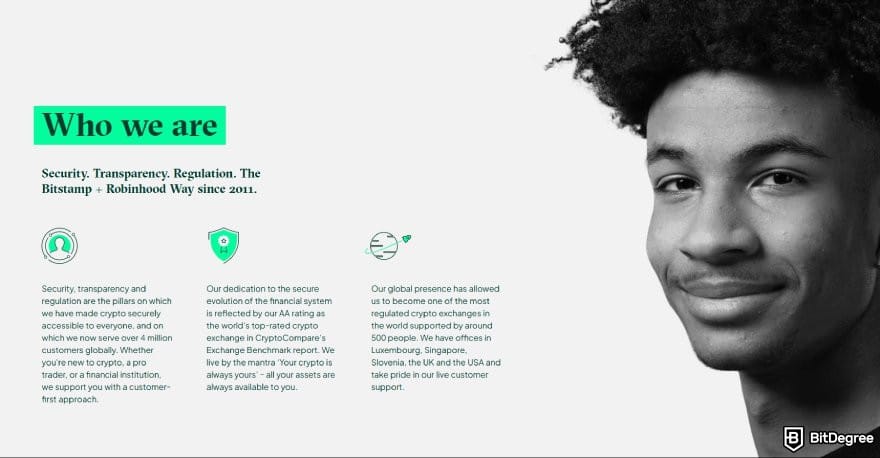
In 2013, Bitstamp moved some of its operations to London. Kodric and Merlak wanted their exchange to be in the center of European banking. However, the UK didn’t have the regulations needed to guide the sale of cryptocurrency.
The pair thought that one of the big problems with crypto trading was that it wasn’t regulated enough. This means that there weren’t enough rules for crypto exchanges to follow. Customers trust businesses that follow the rules.[1] So, Bitstamp looked for a country that had rules!
The former president of PayPal, David Marcus, told Bitstamp to try Luxembourg. In early 2016, Merlak and Kodric had meetings with Luxembourg’s government.
As of writing, Bitstamp still uses its London address as its official HQ location.
By April, Bitstamp had become the world’s first nationally licensed crypto exchange. This meant that Bitstamp would follow Luxembourg’s financial laws. Currently, Bitstamp is licensed in seven countries, including the US, UK, Canada, and Luxembourg. This was a significant victory for Bitstamp and the cryptocurrency industry.

Since then, Bitstamp has linked up with financial institutions around the world. These institutions include Swissquote, Crédit Agricole, and the Chicago Mercantile Exchange. It has become one of the most well-respected and popular exchanges on the market.
In 2023, Bitstamp was listed on the CV VC Global Report as one of the best-performing blockchain projects in the world, as far as cryptocurrency exchange platforms are concerned. This isn't anything to scoff at!
In June 2025, Bitstamp was acquired by Robinhood to expand its global crypto presence and enter international markets.
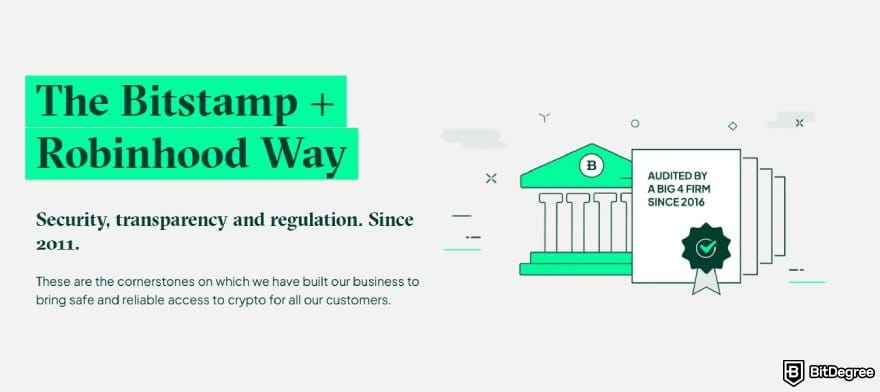
Furthermore, the exchange has also been awarded the "AA Status" by the crypto exchange benchmarking service called CryptoCompare. The "AA Status" has only been awarded to three other exchanges around the world - Coinbase, Binance, and Gemini. With such huge names on the list, it certainly showcases the magnitude of Bitstamp!
Speaking of which, Bitstamp is certainly also one of the biggest crypto exchanges. How big is Bitstamp, though? This wouldn’t be a very good Bitstamp review (and it is a very good Bitstamp review!) if it didn’t look at the numbers. So, let’s do that!
Latest Bitstamp Coupon Found:How Popular is Bitstamp?
At the time of writing, Bitstamp is in the 16th position on BitDegree's exchange tracker. Over $300 million has been used to buy and sell cryptocurrencies on Bitstamp in the last 24 hours!
![]()
Bitstamp makes up between 0.8% and 2–3% of all crypto exchange trading. You can trade with Bitstamp in over 100 countries, from the US to New Zealand, Brazil to South Korea, and many more.
Now, what’s so good about Bitstamp? Let’s find out.

Did you know?
All Crypto Exchanges may look similar to you but they're NOT all the same!
What’s Good About Bitstamp?
As one of the most popular crypto exchanges in the market, Bitstamp comes with a set of benefits that make it stand out from its competitors. Do any of these fit your current needs? Let's take a look at some Bitstamp pros to help you answer this question.
Fiat Trading Available
Bitstamp allows its users to buy cryptocurrencies with fiat currencies. Examples of fiat are the Chinese Yuan (CNY), the US Dollar (USD), and the Japanese Yen (JPY).
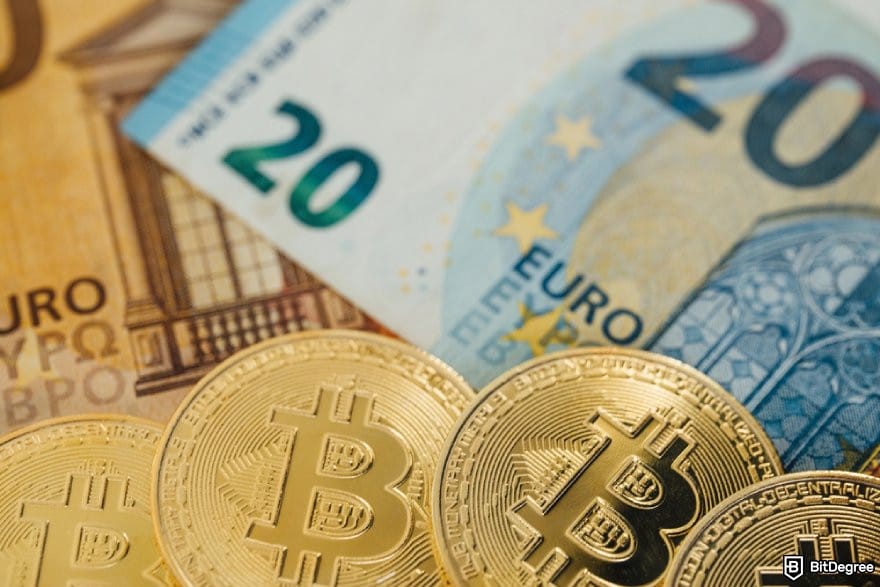
Some crypto exchanges don’t allow trading with fiat currencies. This is bad for beginners who are buying cryptocurrency for the first time. With Bitstamp, you can buy cryptocurrency without having to visit another exchange first.
The fiat currencies you can trade with on Bitstamp are USD, GBP, and EUR. You can also deposit Swiss Francs (CHF) on Bitstamp, but you won’t be able to trade with them. They will be converted into USD or EUR before you can trade with them.
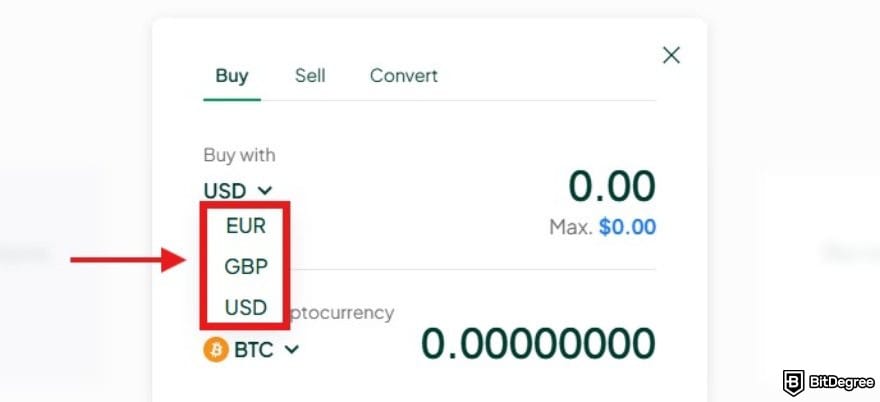
While the fiat option is far more limited when compared to other exchanges like Binance, Kraken, and Bybit, the platform still offers some accessibility, especially to those who have just started out with crypto trading.
Various Supported Payment Methods
Bitstamp allows users to fund their accounts using credit cards and bank transfers. Some exchanges don’t support credit card payments. Bitstamp’s choice of payment types makes your first crypto trade a lot simpler!
You can use Visa or Mastercard credit and debit cards to instantly purchase cryptocurrencies on Bitstamp, but note that this feature is only available in select countries.

Previously, Bitstamp announced support via Visa and Mastercard for users in all 27 EU countries, plus additional jurisdictions such as Switzerland, Norway, Singapore, Hong Kong, South Korea, Australia, Japan, Brazil, Argentina, Israel, South Africa, among others.
According to Bitstamp’s official FAQ, card purchases are not supported in the US, but are available in most other regions, including the European Union, large parts of Asia, Oceania, and selected countries in the Americas and the Middle East.
However, if you're in an unsupported country, the credit/debit card deposit option won’t appear on the deposit page. In that case, you’ll need to rely on bank transfers like SEPA (Europe), SWIFT (international), or ACH (in the US) as fallback funding methods.
Decent Security Measures
In January 2015, Bitstamp was hacked, and 19,000 Bitcoins (BTC) were stolen. The stolen Bitcoins were worth about $5 million! This made a lot of users ask: "Is Bitstamp safe?"
Some platforms, like Mt Gox, have dealt with hacks very poorly. Not Bitstamp, though! The team at Bitstamp has always put customer safety first. In the 2015 hacking incident, no customer funds were lost, and the platform was completely rebuilt to prevent it from happening again.
Bitstamp has worked hard to become one of the most secure exchanges on the market. 95% of its funds are kept in cold storage. This means that they are kept offline, where hackers can’t get to them! Bitstamp funds are also fully insured.

The exchange also offers its users two-factor verification and text message alerts. This is where a user has to give two types of information to access their account. The first is usually a password, and the second is a code created by an app like Google Authenticator.
Quick Tip: Beware crypto exchanges that don’t offer two-factor authentication, unless losing money is your idea of a good time!
Finally, Bitstamp uses PGP (Pretty Good Privacy) to protect sensitive information sent via email or support requests, ensuring user-uploaded documents remain private through secure channels.
So, I believe the answer to "Is Bitstamp safe?" is yes!
Competitive Fees and Great Customer Service
Bitstamp fees are quite low when compared to the rest of the market. They are also easy to understand, which is great for newbies. The platform's fee schedule changes depending on which payment method you’re using and where you live, so we will look at it in more detail later.
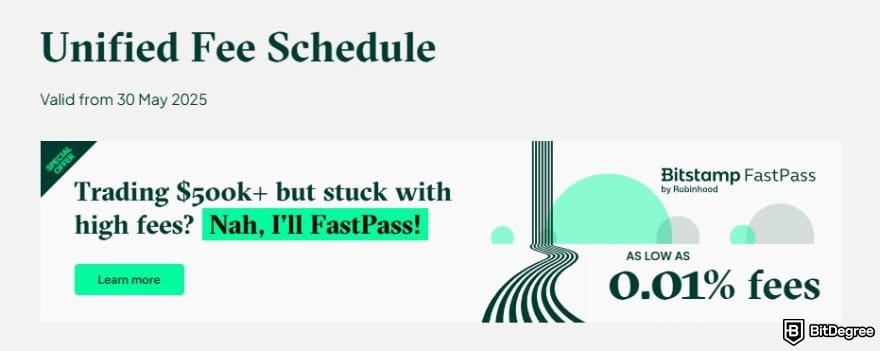
Additionally, the customer is King (or Queen!) at Bitstamp. It wants to keep its traders happy, so the platform responds to user emails within three days and has a UK-based helpline for emergencies. Users will find a detailed FAQ page on Bitstamp’s homepage. Other than that, you can also learn more about a wide range of crypto topics through Bitstamp's learning platform.
All in all, Bitstamp strikes a rare balance with competitive fees, real human support, and a learning hub that doesn’t feel like an afterthought.
Earning Features
Bitstamp’s staking feature, offered through its Earn program, is a neat way to let your crypto work for you without complicated setups. Users can now stake Ethereum (ETH) and Cardano (ADA) directly from their Bitstamp accounts.

What's better is that you keep full control of your crypto. Bitstamp acts only as a service provider, delegating assets to validated nodes, and there’s no internal lock-up period beyond the protocol’s own requirements. Annual yields are competitive: up to 3.10% on ETH and around 1.0% on ADA, with weekly or monthly payouts, depending on the asset.
📚 Related: A Guide to Cardano Staking
To cover its costs, Bitstamp charges a straightforward 15% commission on the staking reward, with no hidden fees.

At the time of writing, Bitstamp Earn Staking is not available to users in the US, Singapore, Japan, and Canada.
Overall, staking at Bitstamp is beginner-friendly and low-effort: you log in, enable staking, and it happens in the background. If you want to earn passive rewards on crypto you already hold, it’s a solid, regulated option.
Strong Reputation
Few crypto exchanges have a better regulatory credibility and financial transparency than Bitstamp. Many consider the platform to be professional and reliable. It has formed links with financial institutions around the world. Bitstamp is also fully licensed and has been audited by a Big Four accountancy company.
In Forbes’s 2025 rankings, Bitstamp earned a 10/10 score for transparency and audit strength, making it the top-rated exchange in Europe and one of the most trusted worldwide. Speaking of which, Bitstamp has a mobile app that's rated 4.8 out of 5 on the App Store, which is simply terrific.
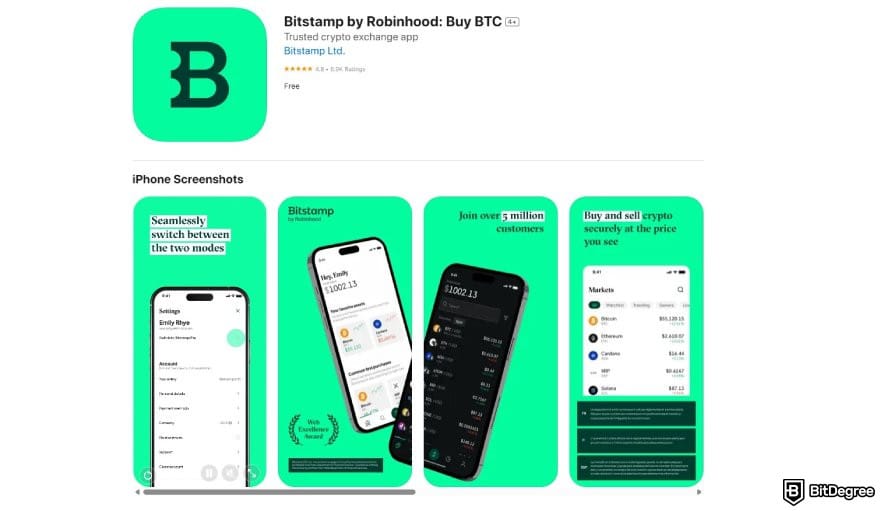
So, this Bitstamp review has talked about the platform’s good bits. Shall we have a look at a couple of notable negative aspects?
What’s Bad About Bitstamp?
Since no exchange is perfect, using Bitstamp also comes with some potential cons. So, let's take a look at some important factors you need to consider before using this platform for your crypto trading activities.
Relatively Limited Coin Selection
Bitstamp only offers around 130 cryptocurrencies for trading. These include Bitcoin (BTC), Bitcoin Cash (BCH), Litecoin (LTC), Ethereum (ETH), and Ripple (XRP).
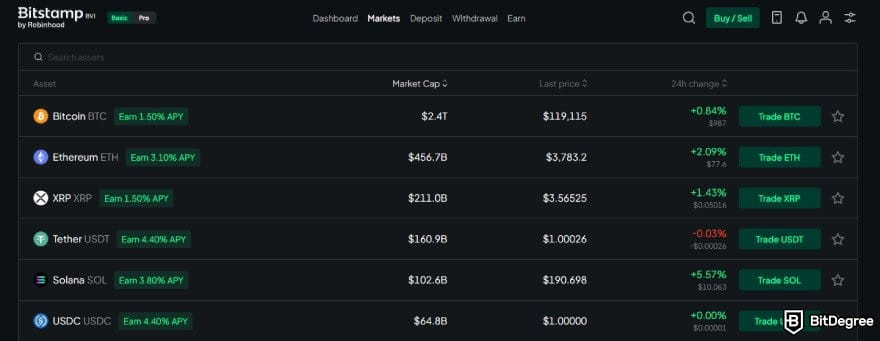
As a beginner, this isn’t a big problem, but when you’re a pro trader, you might want a better selection, especially for more niche coins. Additionally, Bitstamp only offers around 200 trading pairs, whereas Binance, for example, offers more than 1400!
Trading pairs are two currencies you can trade between, like BTC/USD. It’s kind of like a currency exchange booth at the airport. But instead of a fixed rate like “1 USD = 106 JPY,” the price on Bitstamp changes all the time based on the market.
Can be Confusing for Beginners
As a professional trading exchange, Bitstamp can be quite complicated. New users may find Bitstamp difficult to use. The platform is well-designed, but can prove to be a bit too advanced for some newbies. Platforms like Coinbase are sometimes recommended instead of Bitstamp for users with no trading experience.
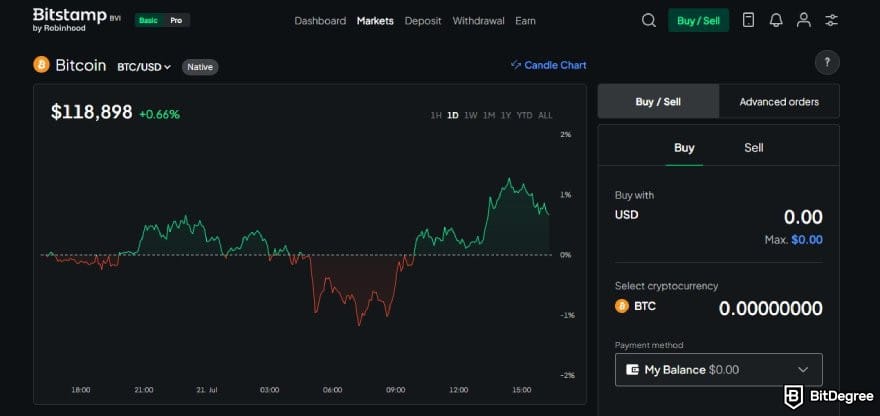
Luckily, you can now easily switch between the Basic and Pro interfaces directly from the dashboard. This is a common and convenient feature, similar to what you see on platforms like Kraken.
How to Start Trading on Bitstamp?
Now you’ve heard the good and the bad, are you ready to start trading? Yes? That’s awesome, because no Bitstamp reviews would be complete without a guide on how to get started. So, to help jumpstart your process with the platform, here is an easy step-by-step guide you can follow.
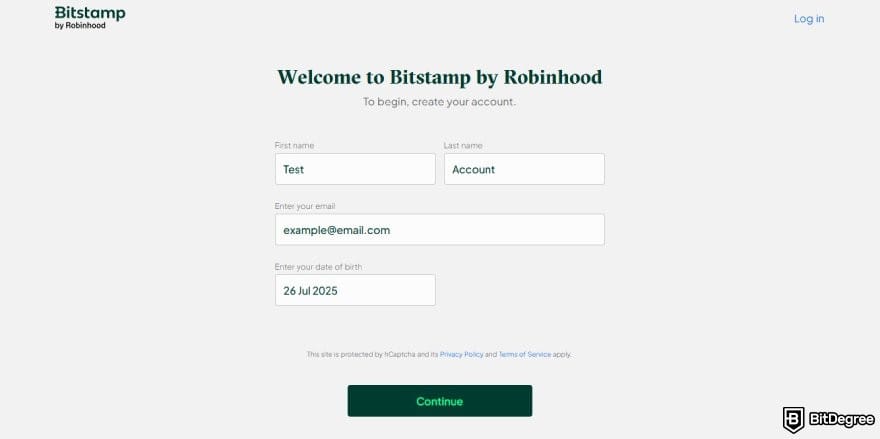
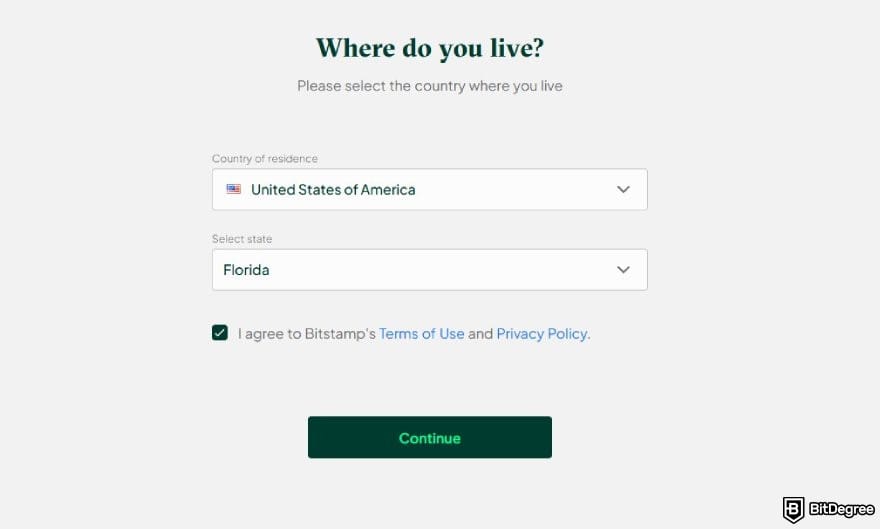
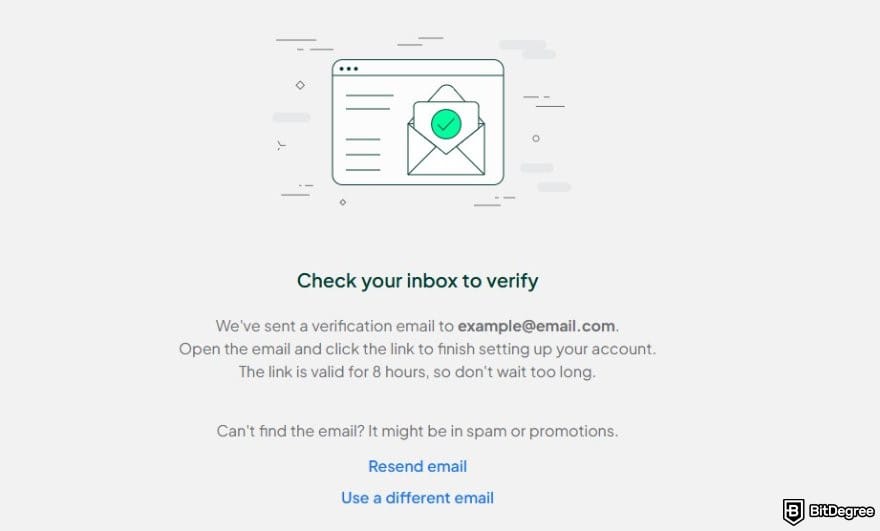
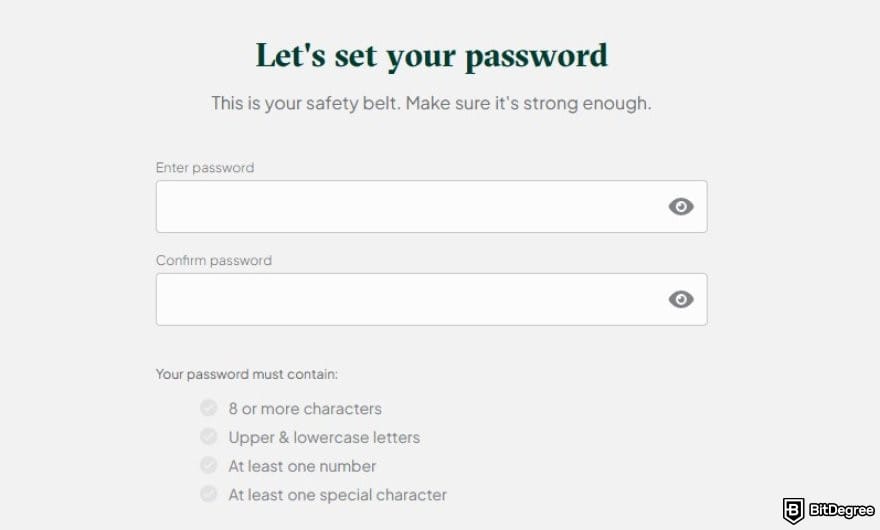
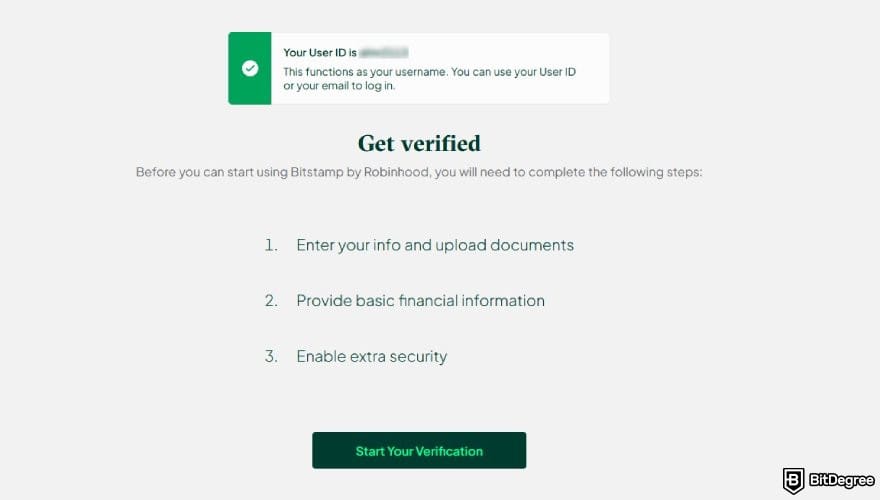
Back then, there were two stages of verification, which made the Bitstamp verification time quite long. Similar to the current state, you must complete both stages to use all the platform’s features.
To complete the first stage, you could go to [Settings] > [Verify Account] > [Identity Verification]. Next, choose [Personal Account Verification]. You’ll then have to upload your driver’s license or passport, as well as proof of address, like a gas bill.
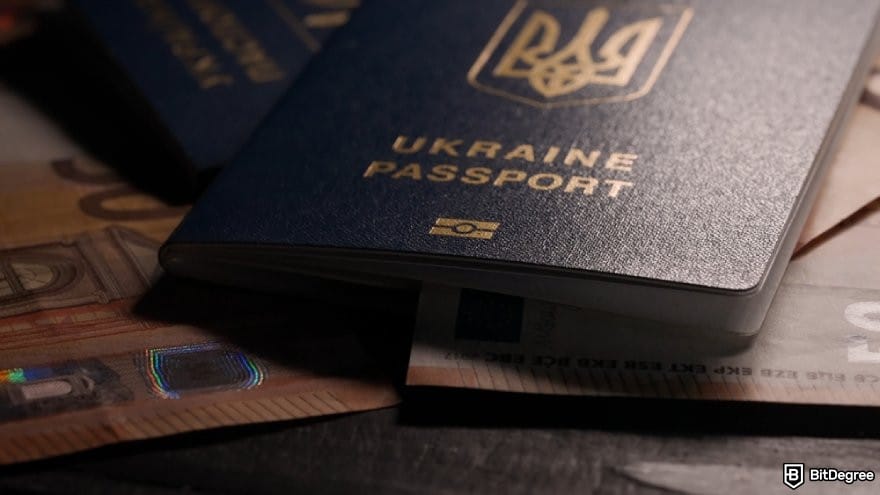
The only difference now is that you have to complete the whole KYC process during the sign-up step. This may deter people who just want to explore the platform before submitting any personal information, but, to be fair, this is a way for Bitstamp to comply with international regulations and anti-money laundering (AML) laws that require exchanges to verify user identities before granting full access.
Once you have completed this stage, your account will be fully verified, and you’ll be ready to start trading!
Crypto Trading
Bitstamp makes it easy for you to buy or sell cryptocurrencies. The platform offers options that suit different levels of crypto traders, no matter if you're a complete beginner or an experienced user. There are basically two main choices: buying directly using fiat and spot trading.
Buying Directly Using Fiat
While the easiest way to make your first crypto trade is arguably with a credit card, you can also opt for other payment options. Let me show you how you can do it on your web browser:

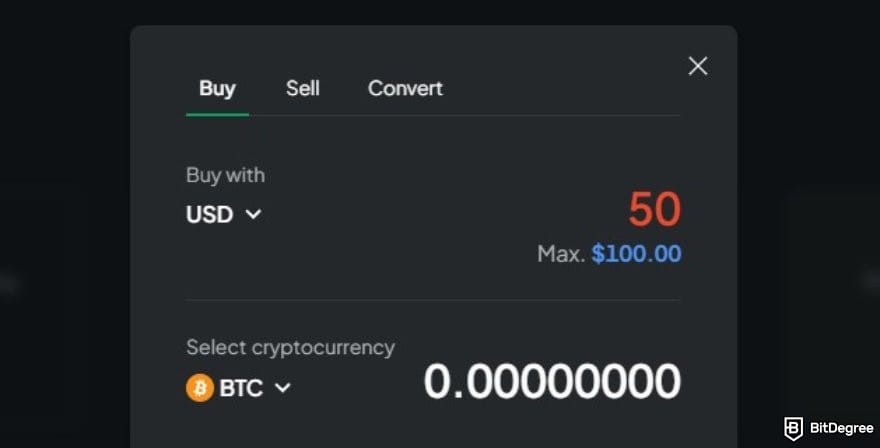
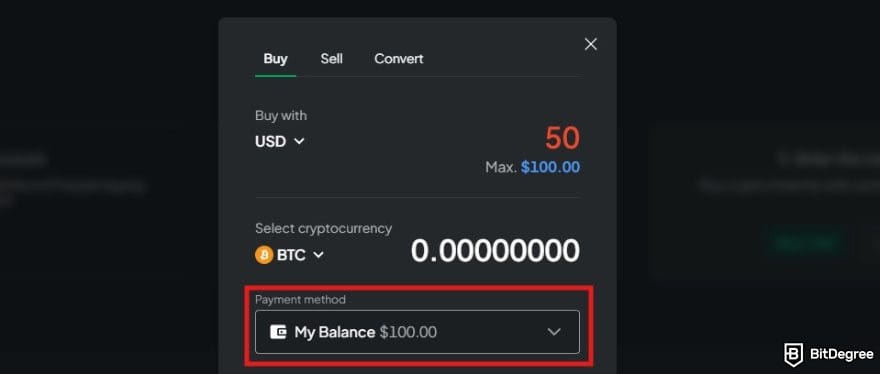
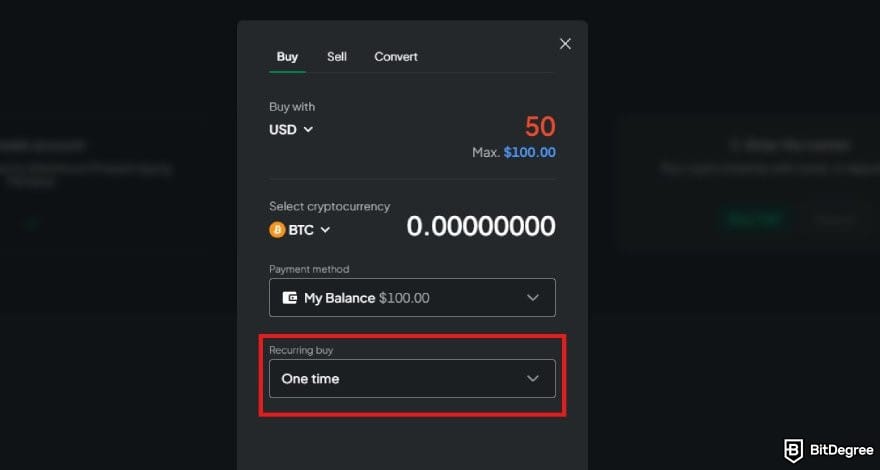
Congratulations, you’re a crypto trader! Pretty cool, right?
Spot Trading
But this is not the only way to buy crypto on Bitstamp. You can also try out the spot trading feature, which can give you more control over your desired price. Follow these steps to do it:
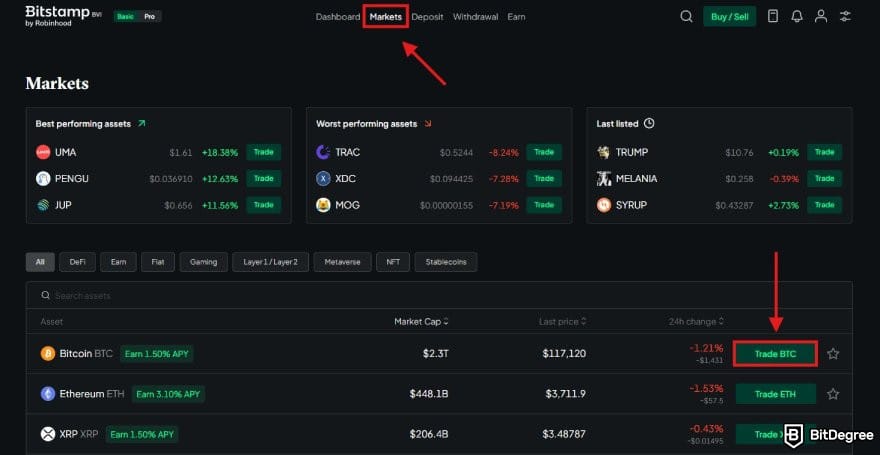
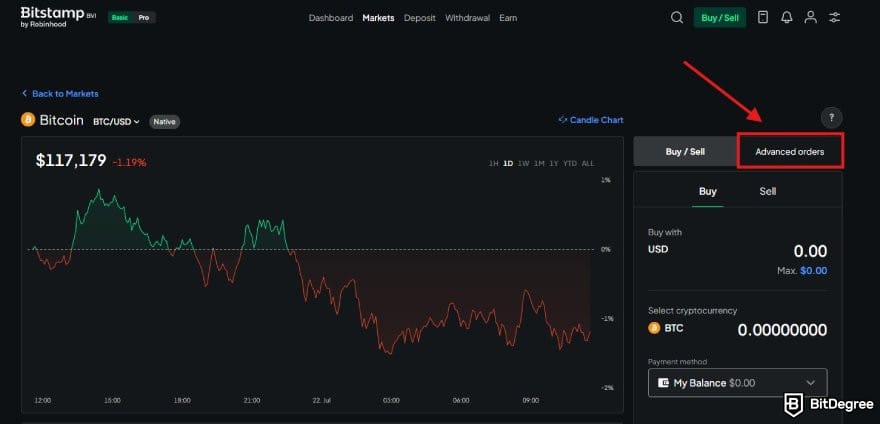
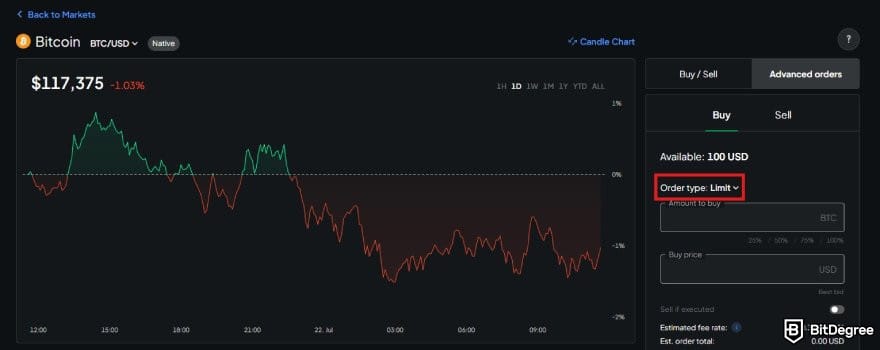
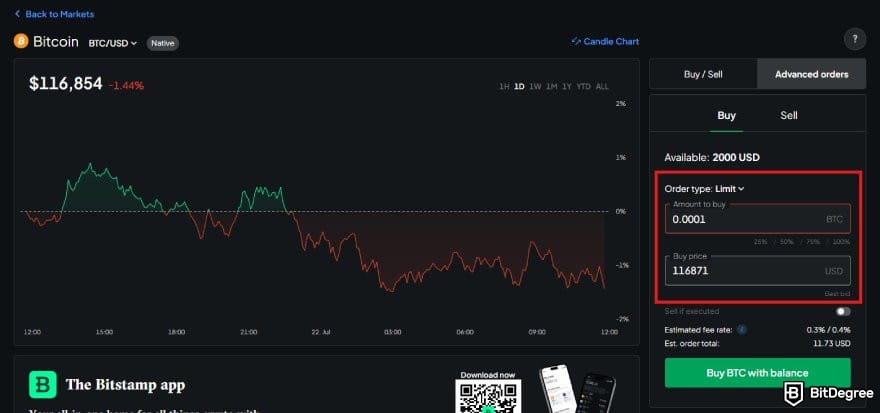
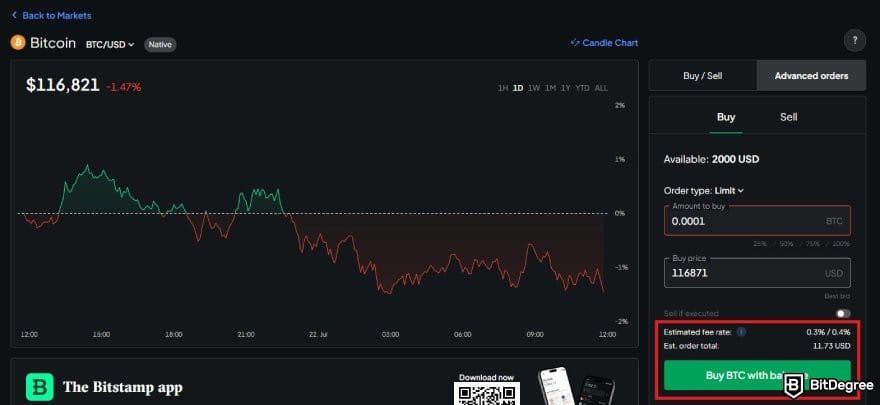
Once your order is fulfilled, the coin should turn up in your account portfolio. One thing I want to highlight is that the interface shown above is the "simplified" version of the spot trading platform.
Note: You can change the trading pair via the drop-down menu above the price chart on the spot trading interface.
If you're an experienced trader and prefer the more fleshed-out UI, you can switch to the Pro interface via the button in the top left corner of the page.
Bitstamp Storage: Is Bitstamp a Wallet?
Once you’ve bought cryptocurrency, you’ll need a secure way to store and access it. The codes that let you manage your crypto, called keys, are kept in wallets. Wallets can be either online (hot wallet) or offline (cold wallet).
Note: A wallet has public and private keys. You can give your public key to anyone, and they can send you cryptocurrency. Your private keys should never be shown to anyone! Think of it as an email account. The public key is your address, and the private key is your password.
So, is Bitstamp a wallet? The answer is sort of, but not really.
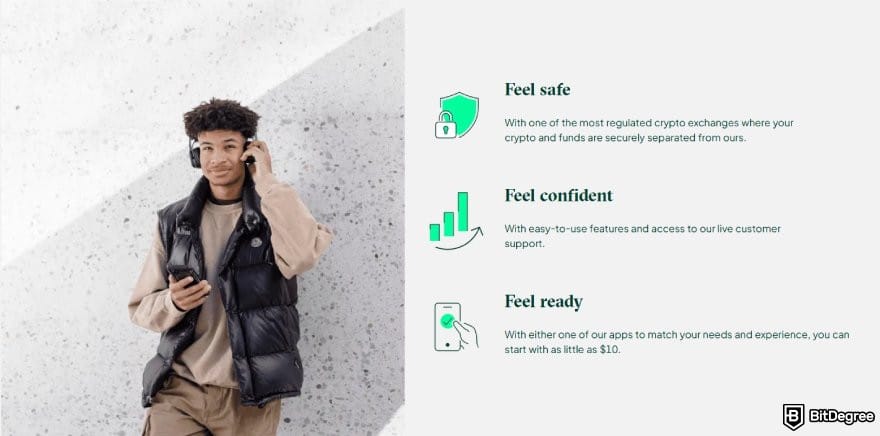
Bitstamp is a crypto exchange that provides custodial wallets, meaning it stores your crypto for you and holds the private keys. It uses both hot and cold wallet storage to help secure your funds. However, it’s not a substitute for having full control of your assets.
📚 Read More: A Guide to Different Types of Crypto Wallets
You should never keep all your crypto online. Exchanges can be convenient but are also frequent targets of cyberattacks.[2] For long-term or large holdings, consider moving your assets to a hardware wallet, which is a physical cold storage device. Ledger Flex, Trezor Safe 5, and Ledger Stax are popular and reliable options.
|
|
|
|
|
|---|---|---|---|
| Hardware | Hardware | Hardware | |
| Extra Secure Crypto Storing & Managing | Safely Storing Your Digital Assets | Secure Crypto Management & Storage | |
| All Ledger Flex Coupons | All Ledger Stax Coupons | All Trezor Safe 5 Coupons | |
| A secure and user-friendly wallet with support for thousands of coins and tokens. | A high-end cryptocurrency wallet with some next-gen features and integrations. | One of the most secure cold hardware wallets on the market. | |
| Visit site Read review | Visit site Read review | Visit site Read review |
Table: Comparison between Ledger Flex, Ledger Stax, and Trezor Safe 5
Bitstamp Fees
Before I finish this Bitstamp review, I want to talk about Bitstamp fees in more detail. Deposits, withdrawals, and trades all have their own fees, and it is important to understand them before you decide to use this platform. So, let me guide you through them in more detail.
Trading Fees
First of all, let's take a look at Bitstamp's trading fees. The platform implements a tier-based maker/taker fee model, meaning that the fees you pay depend on your 30-day trading volume. The more you trade, the lower your fees. Makers, who add liquidity to the market, usually pay slightly less than takers, who remove liquidity by matching existing orders.
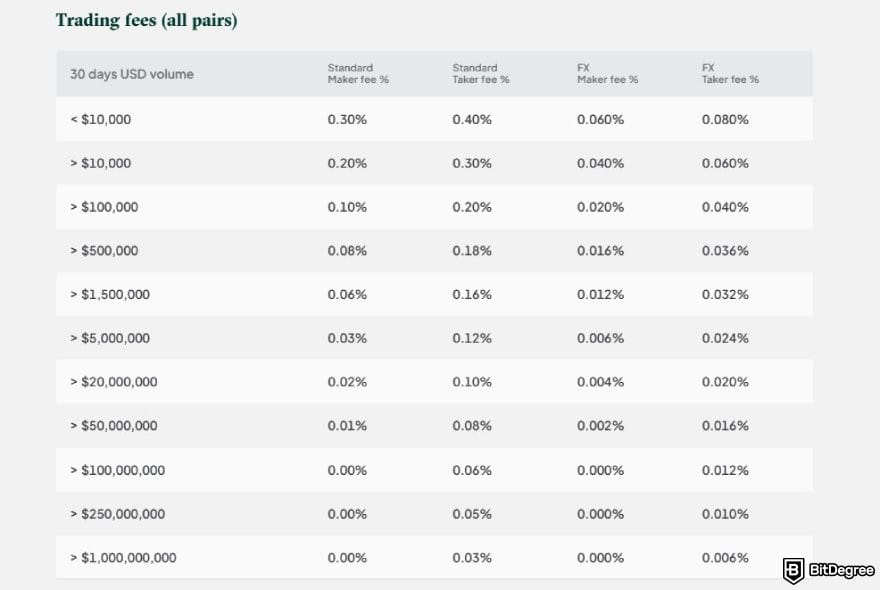
The fees start from 0.30% for makers and 0.40% for takers. They can go as low as 0.00% and 0.03% with higher 30-day trading volume. However, there is an additional charge for spread if you're using the basic trading option, which ranges from 0.5% to 1.8% depending on what cryptocurrency you choose.
If you prefer buying crypto instantly, you should be aware that the fee is significantly higher. Bitstamp will charge you 4% for every credit card, Google Pay, Apple Pay, and PayPal purchase. Note that your card issuer might also charge additional fees for your transaction.
Deposit and Withdrawal Fees
Now, how about Bitstamp deposit and withdrawal fees? Take a look at this table for fiat deposits and withdrawals based on the method you choose:
SEPA | ACH | Faster Payments (UK) | International wire | |
|---|---|---|---|---|
Deposit | Free | Free | Free | 0.05% |
Withdrawal | €3.00 | Free | £2.00 | 0.1% |
Table: Fiat deposit and withdrawal fees on Bitstamp
Luckily, depositing crypto to your Bitstamp account is free. But, there will be an additional charge when you withdraw coins to an external address. This fee consists of Bitstamp's estimate of the network transaction fees within a certain time period and Bitstamp's crypto withdrawal processing fee. You can check the exact amount before you finalize your crypto withdrawal.
Please note that the fee schedule might change from time to time. Consider checking the official page regularly to get the most up-to-date information.
So far, you’ve learned a lot about Bitstamp. Next, this Bitstamp review will look at Bitstamp’s users. Who is Bitstamp designed for?
Who is Bitstamp Best for?
Bitstamp is a safe and reliable platform. It has millions of happy users. However, beginners may find the platform difficult to use. The professional design and features of Bitstamp are great for more experienced users, but might confuse newbies.
That said, Bitstamp has made its interface much more beginner-friendly by allowing users to switch between Basic and Pro modes. This update makes it easier for newcomers to navigate the platform without sacrificing advanced features for experienced traders.
Bitstamp offers fiat trading and credit card purchases. This makes getting started quick and easy. Bitstamp is a perfect exchange for users who can’t wait to start trading. Just remember that the fee associated with this method is significantly higher.
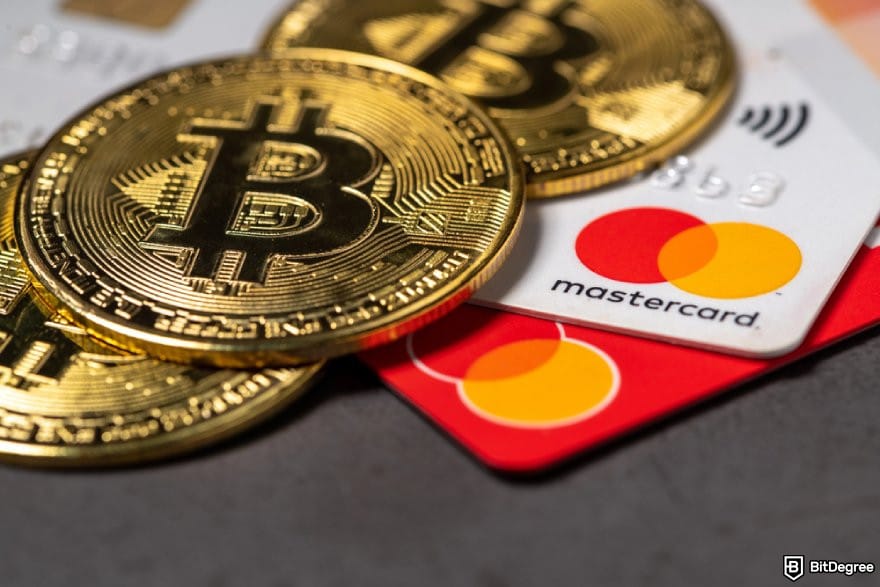
Currently, Bitstamp supports over 130 cryptocurrencies. For many traders, especially those focused on popular coins, this is more than enough. However, if you're interested in more niche or newly launched tokens, Bitstamp’s coin selection might feel a bit limited compared to exchanges with a wider asset range.
Conclusions
Bitstamp has great security and a team that really cares about its users. It's becoming one of the world’s most trusted crypto exchanges. Plus, its recent acquisition by Robinhood could help expand its reach and strengthen its regulatory position even further. If you can work out the basics, then Bitstamp could be right for you.
Now it’s time to answer that question for yourself. So, register, verify your account, and start trading on Bitstamp!
When you’ve made your first trade, let me know what you think… Is Bitstamp legit? Was this Bitstamp review helpful? You tell me! I’d love to hear what you think!
The content published on this website is not aimed to give any kind of financial, investment, trading, or any other form of advice. BitDegree.org does not endorse or suggest you to buy, sell or hold any kind of cryptocurrency. Before making financial investment decisions, do consult your financial advisor.
Scientific References
1. Gupta V., Shukla, S.: 'Consumer Trust in Digital Banking: A Qualitative Study of Legal and Regulatory Impacts';
2. Oosthoek K., Doerr, C.: 'Cyber Security Threats to Bitcoin Exchanges: Adversary Exploitation and Laundering Techniques'.




